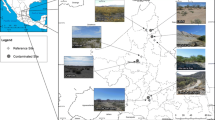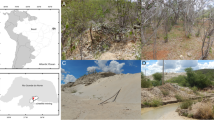Abstract
Purpose
Mining has been carried out in San Luis Potosi, Mexico, since 1592, which has led to severe pollution issues affecting both the environment and human health. To address this, remediation projects have been initiated to restore the soil and its ecosystem services. These efforts involve removing the contaminants and restoring the soil’s health and quality. This study aims to assess the biochemical impact of soil remediation carried out in the field, on areas that have been heavily contaminated with heavy metals over a prolonged period.
Methods
The enzymatic activity, physiological profile, structure, and microbial diversity were used as bioindicators to assess the remediation of soil and two reference soils.
Results
The results indicated that Pb and As decreased, but not at levels indicated by Mexican regulations, Cd concentrations decreased to be below Mexican regulations, the enzymatic activity between the soil with and without remediation did not present significant differences, both with low activity, arylsulfatase was the one with the highest inhibition, and urease the most activated. The evolution of the physiological activity of the microorganisms was greater in the remediated soil. Normal values of evenness and diversity were observed in soils with and without remediation, likewise, the consumption of substrates initially was towards carbohydrates and amines/amides, but in the end, carboxylic acids and polymers were consumed.
Conclusion
The remediation process shows positive results; the recovery of soil health is in progress. It was demonstrated that the bioindicators used were adequate to evaluate the soil remediation process.




Similar content being viewed by others
References
Bone J, Head M, Barraclough D et al (2010) Soil quality assessment under emerging regulatory requirements. Environ Int 36:609–622
Cele EN, Maboeta M (2016) Response of soil enzyme activities to synergistic effects of biosolids and plants in iron ore mine soils. Int J Environ Sci Technol 13:2117–2126. https://doi.org/10.1007/s13762-016-1043-y
Chae Y, Cui R, Kim SW, An G, S-W, An Y-J, (2017) Exoenzyme activity in contaminated soils before and after soil washing: ß-glucosidase activity as a biological indicator of soil health. Ecot Environ Safety 135:368–374. https://doi.org/10.1016/j.ecoenv.2016.10.007
Cookson JT (1995) Bioremediation engineering: design and application. Mc. Graw Hill, New York, ISBN: 0-07-012614-3, pp 314–317
CEFIM-Coordinación Estatal para el Fortalecimiento Institucional de los Municipios (2012) Monografías de los municipios de México. San Luis Potosí. Accessed September 10, 2020. http://www.cefimslp.gob.mx/monografias_municipales/2012/sanluispotosi/files/san%20luis%20potosi.12.pdf
Cui Y, Wang X, Wang X, Zhang X, Fang L (2021) Evaluation methods of heavy metal pollution in soils based on enzyme activities: a review. Soil Ecol Lett 3(3):169–177
Dhaliwal SS, Singh J, Taneja PK, Mandal A (2019) Remediation techniques for removal of heavy metals from the soil contaminated through different sources: a review. Environ Sci Pollut Res. https://doi.org/10.1007/s11356-019-06967-1
Diario Oficial de la Federación DOF (2002) Norma Oficial Mexicana (NOM - 021 -RECNAT- 2000) Que establece las especificaciones de fertilidad, salinidad y clasificación de suelos. Estudio, muestreo y análisis. [Official Mexican Standard, which fixed the fertility, salinity and soil classification. Study, sampling and analyses] Mexico. Accessed October 13, 2020. http://www.ordenjuridico.gob.mx/Documentos/Federal/wo69255.pdf
Diario Oficial de la Federación (DOF) (2007) Norma Oficial Mexicana (NOM-147-SEMARNAT/SSA1–2004) Que establece criterios para determinar las concentraciones de remediación de suelos contaminados por arsénico, bario, berilio, cadmio, cromo hexavalente, mercurio, níquel, plata, plomo, selenio, talio y/o vanadio. [Official Mexican Standard that establishes criteria to determine the remediation concentrations of soils contaminated by arsenic, barium, beryllium, cadmium, hexavalent chromium, mercury, nickel, silver, lead, selenium, thallium and/or vanadium] Mexico. Accessed January 17, 2020. https://www.gob.mx/profepa/documentos/norma-oficial-mexicana-nom-147-semarnat-ssa1-2004
Dick R (2011) Methods of soil enzymology, Soil Science Society of America. USA, ISBN: 978-0-89118-854-4, pp 104–108, 165–168, 195–198, 250–256
Epelde L, Mijangos I, Becerril JM, Garbisu C (2009) Soil microbial community as bioindicator of the recovery of soil functioning derived from metal phytoextraction with sorghum. Soil Biol Biochem 41(9):1788–1794
FAO, ITPS (2015) Status of the world’s soil resources (SWSR) – main report. Food and Agriculture Organization of the United Nations and Intergovernmental Technical Panel on Soils, Rome, Italy. https://www.fao.org/3/i5199e/i5199e.pdf
Fernández-Macías JC, González-Mille DJ, García-Arreola ME et al (2020) Integrated probabilistic risk assessment in sites contaminated with arsenic and lead by long-term mining liabilities in San Luis Potosi, Mexico. Ecotoxicol Environ Saf 197:1–8. https://doi.org/10.1016/j.ecoenv.2020.110568
Hernández-Allica JA, Becerril JM, Garbisu C (2008) Assessment of the phytoextraction potential of high biomass crop plants. Enviro Pollut 25(1):32–40. https://doi.org/10.1016/j.envpol.2007.06.002
Instituto Nacional de Estadística y Geografía (INEGI) (2017) Anuario estadístico y geográfico de San Luis Potosí 2017. Mexico. Accessed December 12, 2023. https://www.inegi.org.mx/contenidos/productos/prod_serv/contenidos/espanol/bvinegi/productos/nueva_estruc/anuarios_2017/702825092122.pdf
Kumpiene J, Guerri G, Landi L, Pietramellara G, Nannipieri P, Renella G (2009) Microbial biomass, respiration and enzyme activities after in situ aided phytostabilization of a Pb- and Cu-contaminated soil. Ecot Environ Safety 72:115–119. https://doi.org/10.1016/j.ecoenv.2008.07.002
Lee S, Kim M, Kim J et al (2020) Use of soil enzymes as indicators for contaminated soil monitoring and sustainable management. Sustainability 12:8209. https://doi.org/10.3390/su12198209
Magurran AE (2004) Ecological diversity and its measurement. Princeton University Press, New Jersy, USA, p 179
Martínez-Toledo A, Montes-Rocha A, González-Mille DJ et al (2017) Evaluation of enzyme activities in long-term polluted soils with mine tailing deposits of San Luis Potosí, México. J Soil Sediment 17:364–375. https://doi.org/10.1007/s11368-016-1529-8
Martínez-Toledo A, González-Mille DJ, García-Arreola ME et al (2019) Patterns in utilization of carbon sources in soil microbial communities contaminated with mine solid wastes from San Luis Potosi. Mexico Ecot Environ Safety 208:111493. https://doi.org/10.1016/j.ecoenv.2020.111493
Ortíz BN, Sanz GJ, Dorado VM, Villar FS (2007) Técnicas de recuperación de suelos contaminados. Universidad de Alcalá, España
Pardo T, Clemente R, Alvarenga P, Bernal MP (2014) Efficiency of soil organic and inorganic amendments on the remediation of a contaminated mine soil: II. Biological and Ecotoxicological Evaluation Chemosphere 107:101–108. https://doi.org/10.1016/j.chemosphere.2014.03.017
Pérez-Martínez I, Romero FM (2015) Uso de parámetros indirectos para la evaluación de la contaminación de suelos por metales pesados en una zona minera de San Luis Potosí, México. Boletín De La Sociedad Geológica Mexicana 67(1):1–12
Popek E (2018) Sampling and analysis of environmental chemical pollutants. Elsevier. ISBN 978-0-12-803202-2. https://doi.org/10.1016/C2014-0-03819-1
Ren K, Teng F, Liu S, Liu X (2022) Analysis of the effect of soil remediation processes contaminated by heavy metals in different soils. Water 14:4004. https://doi.org/10.3390/w14244004
Secretaria de Economía (SE) (2018) Subsecretaria de minería, Servicio Geológico Mexicano. Panorama minero del Estado de San Luis Potosí. Accessed February 10, 2021. http://www.sgm.gob.mx/pdfs/SAN_LUIS_POTOSI.pdf
Sharma SK, Ramesh A, Sharma MP, Joshi OP, Govaerst B, Steenwerth KL, Karlen DL (2010) Microbial community structure and diversity as indicators for evaluating soil quality. In: Lichtfouse E (ed) Biodiversity, biofuels, agroforestry and conservation agriculture, sustainable agriculture reviews 5, Springer Science+Business Media BV. pp 317–330. https://doi.org/10.1007/978-90-481-9513-8_11
Shen W, Zhu N, Cui J, Wang H, Dang Z, Wu P, Luo Y, Shi C (2016) Ecotoxicity monitoring and bioindicator screening of oil-contaminated soil during bioremediation. Ecot Environ Safety 124:120–128. https://doi.org/10.1016/j.ecoenv.2015.10.005
Secretaría de Medio Ambiente y Recursos Naturales (SEMARNAT) (2016) Informe de la Situación del Medio Ambiente en México. Compendio de Estadísticas Ambientales. Indicadores Clave, de Desempeño Ambiental y de Crecimiento Verde. Edición 2015. Informe de la Situación del Medio Ambiente en México. | Instituto Nacional de Ecología y Cambio Climático | Gobierno | gob.mx (www.gob.mx). Accesed February 10, 2023
Song B, Zeng G, Gong J, Liang J et al (2017) Evaluation methods for assessing effectiveness of in situ remediation of soil and sediment contaminated with organic pollutants and heavy metals. Environ Int 105:43–55
Tang J, Zhang J, Ren L et al (2019) Diagnosis of soil contamination using microbiological indices: a review on heavy metal pollution. J Environ Manage 242:121–130. https://doi.org/10.1016/j.jenvman.2019.04.061
Volke ST, Velasco TJA (2002) Tecnologías de remediación para suelos contaminados. INE-SEMARNAT, Mexico. [Remediation technologies for contaminated soils. Mexico] INE-SEMARNAT; 2002. http://www.ecopuerto.com/Bicentenario/informes/TecnologiasRemediacion.pdf
Wasilkowski D, Mrozik A, Piotrowska-Seget Z et al (2014) Changes in enzyme activities and microbial community structure in heavy metal-contaminated soil under in situ aided phytostabilization. Clean – Soil, Air, Water 42(9999):1–8. https://doi.org/10.1002/clen.201300631
Weber KP, Legge RL (2010) Community-level physiological profiling. In: Cummings SP (ed) Bioremediation, chapter 16, methods in molecular biology, 599. Springer Science+Business Media, LLC, Humana Press, pp 263–281. https://doi.org/10.1007/978-1-60761-439-516
Xian Y, Wang M, Chen E (2015) Quantitative assessment on soil enzyme activities of heavy metal contaminated soils with various soils properties. Chemosphere 239:604–608. https://doi.org/10.1016/j.chemosphere.2014.12.060
Xu W, Ge Z (2015) Application and optimization of Biolog Ecoplates in functional diversity studies of soil microbial communities. MATEC Web Conferences 22:04015. https://doi.org/10.1051/matecconf/20152204015
Yao Z, Lib J, Xiec H, Yuc C (2012) Review on remediation technologies of soil contaminated by heavy metals. Procedia Environ Sci 16:722–729
Funding
The authors would like to thank the National Council for the Humanities, Sciences and Technologies (Investigadoras e Investigadores por México, CONAHCYT project No. 553). We also thank the anonymous reviewers for their contributions to the manuscript.
Author information
Authors and Affiliations
Corresponding author
Ethics declarations
Competing interests
The authors declare no competing interests.
Additional information
Responsible editor: Fabian Fernandez Luqueño
Publisher's Note
Springer Nature remains neutral with regard to jurisdictional claims in published maps and institutional affiliations.
Supplementary Information
Below is the link to the electronic supplementary material.
Rights and permissions
Springer Nature or its licensor (e.g. a society or other partner) holds exclusive rights to this article under a publishing agreement with the author(s) or other rightsholder(s); author self-archiving of the accepted manuscript version of this article is solely governed by the terms of such publishing agreement and applicable law.
About this article
Cite this article
Martínez-Toledo, Á., Espinosa-Reyes, G., González-Mille, D.J. et al. Biochemical evaluation of the remediation of weathered and contaminated soil with heavy metals. J Soils Sediments (2024). https://doi.org/10.1007/s11368-024-03776-z
Received:
Accepted:
Published:
DOI: https://doi.org/10.1007/s11368-024-03776-z




